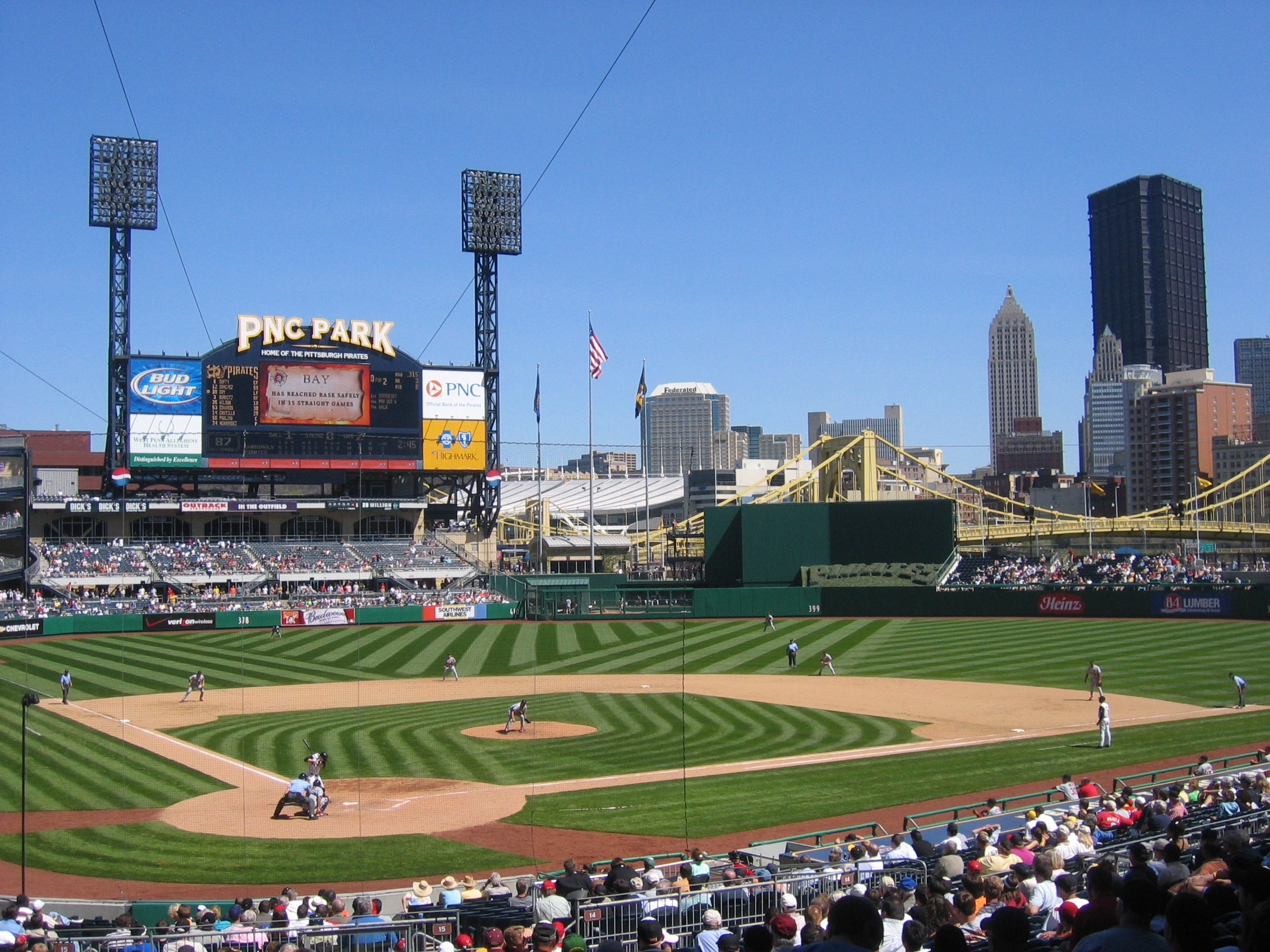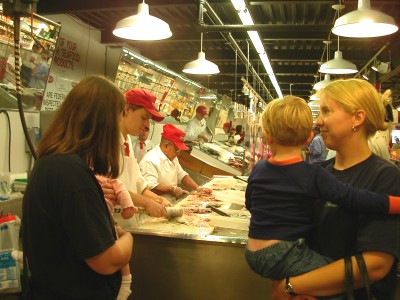Attractions
PNC Park: If you never heard of PNC Park it is the home of the Pittsburgh Pirates. PNC park is actually the second smallest MLB baseball field. But it is also ranked the nicest park in the world. The main reason behind this is that from your seat you can see a breathtaking view of the city’s skyline. PNC Park is also noted for having the best food of any major league venue. The restaurants that are located in the stadium are Primanti Brothers, Quaker Steak and Lube, and an Outback steakhouse.
Side Notes on PNC park:
- The right field wall is 21 feet high in dedication to Roberto Clemente who wore number 21 as a pirate.
- When the pirates hit a homerun fireworks are light off from center field.
- In 2006 PNC park hosted the allstar game and the homerun derby.
Seating Capacity: 38,496
Jason Bay’s Recent stats: The home run was Bay’s 13th of the season but only his second in the last 25 games. Bay, who also drove in four runs, hit 35 homers last season when he was voted to the National League starting lineup in the All-Star Game. Bay was in a 1-for-24 slump prior to his home run and had hit just .130 since June 4, a slide that dropped his batting average to .250, before going 2 for 4 on Sunday.
Freddy Sanchez: Sanchez went 2-for-4 with a solo homer and two RBI’s in fridays win over the Cubs.
Hitting Average: .296
Home Runs: 2
RBI: 32
Runs: 33
Heinz Field: Located within walking distance from PNC park is Heinz field, the home of the Pittsburgh Steelers. This park was made because the original Three River Stadium was demolished. The stadium is a bowl design with an open end on the south side. The playing surface in this field is different because it is natural grass. The field features underground heating to get the grass through the intense pittsburgh winter. But a downside to this is it makes kicking field goals in the stadium very tough. The farthest field goal ever kicked in this park is 50 yards by Jeff Reed.
Heinz Field Facts:
You’re closer to the action at Heinz Field! Unlike other multi-purpose facilities, Heinz Field is designed around the dimensions of the playing surface, creating a closer, more intimate fan experience. The first row of seats on the east and west sides are approximately 55 ft. from the sideline, while the north and south ends are about 25 ft. from the back of the endzone. The upper deck is stacked and overlaps the lower deck, bringing the fans in the upper deck seats closer to the field. Heinz Field’s seats are designed to provide extra room and are contoured for greater comfort.
The Pittsburgh Steelers have one of the finest football stadiums in the country to call home!
Situated just north of Pittsburgh’s Point State Park, the horseshoe shaped stadium seats 64,450 people and provides a stunning view of the city’s breathtaking skyline and three rivers. Among its amenities are 127 luxury suites.
The Strip District of Pittsburgh:
When you here the word strip district you most likily think it is like a red light district. But really what it is is a region of Pittsburgh that is Known for it’s wholesalers, restaurants, and funcky shops. The strip is a favorite weekend destination for Pittsburghers and a must see for out of town visitors.
The Strip district is a flat strip of land on the Allegheny River’s south shore just east of downtown. Recently in the strip they have been making new restaurants and dance clubs. But your Strip district experience isn’t complete untill you make a stop at Wholey’s. Wholey’s is the regions largest seafood wholesalers.
Here is a sample of food that Wholey’s has to offer.
| BEEF | LAMB | PORK | POULTRY | DELI |
| SEAFOOD | FROZEN FOODS | APPETIZERS, DIPS | SOUPS, BASES | FRESH SALADS |
| DESSERTS | CONDIMENTS, DRESSINGS, OILS | BREADING/BATTER | SAUCES, MARINADES, SEASONINGS |
Another thing that makes the strip district so unique is the street vendors. Street vendors are people on the street selling goods on tables. Street vendors usually sell ethnic food, used CD’s, watches, pittsburgh city prints, shirts, and sunglasses just to name a few.
Pittsburgh’s Incline:
Located just across from station square is Pittsburgh’s Incline.
In May, the Duquesne Incline celebrated 130 years of operation in Pittsburgh. Designed and built by Samuel Diescher, the country’s foremost builders of inclines, the Duquesne Incline officially opened for business back on May 20, 1877 and served as one of four original inclines used to transport passengers and freight to the residential area along “Coal Hill,” which today is known as “Mt. Washington.”
Built at a cost of $147,000, the historic incline was operated by The Duquesne Inclined Plane Company from 1877-1962. Financial problems almost caused the incline to close in 1963.
To pay for the incline you pay less than 2.oo dollars befour you get on. Then it takes you up to Mt. Washington where you can stay for a while and eat at one of the many fine restaurants.
Kennywood Park:
Kennywood Park is Americas favorite amusement park, and a national historic landmark. Founded in 1898 as a small trolley park near Pittsburgh, Kennywood was begun by the Monongahela Street Railway Company, which was controlled by Andrew Mellon. Today’s Kennywood still contains two major buildings dating from 1898 — a carousel pavilion and a restaurant (originally the Casino).
To read more about Kennywood go to the Kennywood Park page.
Carnegie Science Center:
Recipient of the 2003 National Award for Museum Service, Carnegie Science Center inspires and entertains by connecting science and technology with everyday life. In addition to providing valuable scientific experiences, Carnegie Science Center engages in outreach programs that serve Pittsburgh’s diverse community. The Science Center is located on Pittsburgh’s North Shore along the banks of the Ohio River and is accessible to persons with disabilities.
First Floor:
The first floor of the Science Center has two major attractions. The first and best attraction is the Omnimax Theater. This is a four story- domed screen with hundreds of speakers. This is the only one in Western Pennsylvania. Some of the shows that are played on this is Wired to Win, Roving Mars, and Deep Sea. The next is the Science Stage which is perfect for big groups! Explore scientific topics in a big way in a Science Stage demonstration. And the last attraction on this floor is the SciQuest. SciQuest lets you step inside a wind tunnel, feel an earthquake, or control a four-foot tornado as you explore the forces of nature, the physics of flight and sound, and the science of light and waves.
The Second Floor:
The first attraction on this floor is the Buhl Digital Dome. This 50-foot domed planetarium literally takes visitors into space. Explore Mars, navigate the stars, or journey through the mysteries of the cosmos. Come on Friday or Saturday night for a live laser fantasy show where color and music surround you. The next attraction on the floor is the Science stage. This lets you Get into the act as science comes alive in this participation demonstration theater.
Buhl Digital Dome:
The new high-definition projection system will deliver cutting-edge imagery — from distant galaxies and black holes to brain cells — and expand the kind of material presented in the planetarium’s programs to other scientific disciplines.
To reflect this expanded potential, the Henry Buhl Jr. Planetarium and Observatory is being renamed the Buhl Digital Dome. The new system was funded by a $1 million grant from the Buhl Foundation, the largest gift to the science center in 2006.
The Third Floor:
The third floors main attraction is the SeaScape.
Which kinds of animals live in a coral reef? What is symbiosis? Discover answers to these questions and many more at the Science Center’s underwater encounter, SeaScape. Explore what’s under the sea in our 2000 gallon, interconnected, five-tank living coral reef ecosystem, containing well over 400 species of plants and animals, including live mangrove trees. Examine microscopic life at MicroSeaScape, or just relax and enjoy the view!
The next attraction on this floor is the Kitchen Theater. This lets you discover science you can eat in this hands-on demonstration theater.
The Fourth Floor:
And the last floor has two main attractions. The first attraction is the Exploration Station. This exhibition, located on the fourth floor, is 8000 square feet of fun-filled activities and exhibits that encourage open-ended exploration and problem-solving. Here children can discover the how and why of science concepts and processes as diverse as magnetic forces, lasers, aerodynamics and embryology.
Meet new friends while you work together on…
- Launching air rockets
- Constructing working electrical circuits
- Playing the laser harp and the PVC pipe organ
- Engineering dams, locks, channels and flood plains to control the flow of a river
The next attraction is the Ecostation. DEP Air Monitoring Station: The official Allegheny County Air Quality Monitoring Station, owned and operated by the Department of Environmental Protection (DEP). This unique display samples air outside the southern face of Carnegie Science Center and monitors the air quality using a myriad of high-tech sensors and equipment.
No comments yet.











Leave a comment